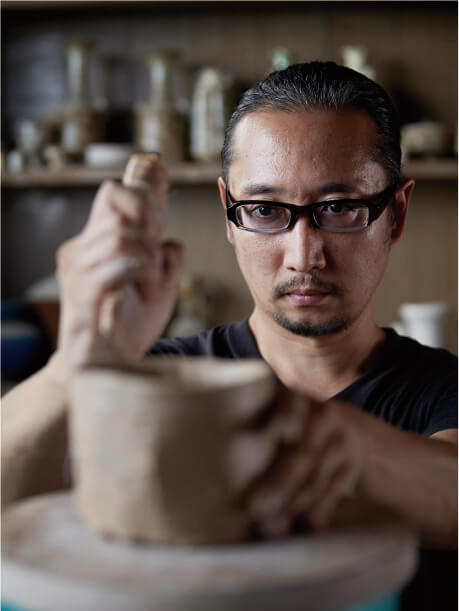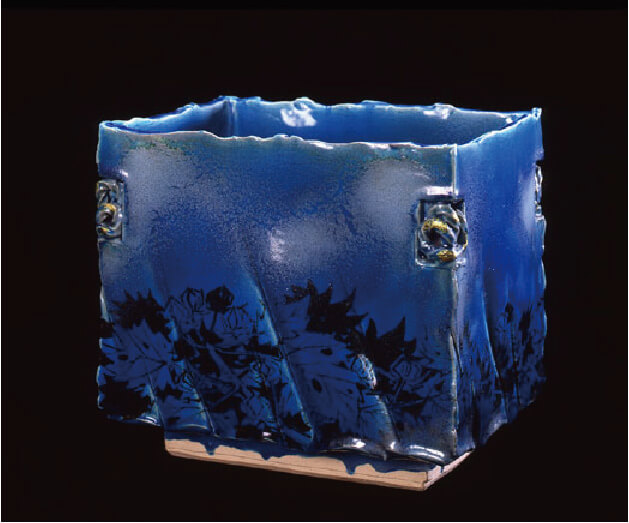A quest for beauty that continues for over two hundred years
The successive pottery owners as named Kobei every generation have always pursued new design and shapes, through trial and error, and challenged themselves to create beauty as ceramic artists.
These achievements have been highly evaluated in the nationwide and abroad, too.
The pursuit of excellence in technology and beauty.
The potter’s creativity is the philosophy of Kobeigama for every generation, and it has been purely and intensely passed on.
Kobei Kato the first to the fourth
The first pottery was opened in Ichinokura, Tajimi in 1804.
He produced blue painted tableware in the ascending kiln, which soon became the official kiln for the Honmaru the main enclosure and West Imperial Parks of Edo Castle.
The second generation has left behind the finely blue painted excellent products.
The third generation immersed himself in the study of blue painting in Chinese Xuande style.
The fourth generation of the family was known as a master craftsman, and also created modern ceramics painting techniques.
Kobei Kato the fifth

He made full use of a wide range of techniques, including Chinese ceramics such as Seiji(celadon), Tenmoku, Sometsuke(painting), Akae(red painting), and Kinrande(gold brocade), as well as techniques derived from Qianshan and Liang dynasty. He was designated an Important Intangible Cultural Property by Gifu Prefecture in 1973.
He is the founder of the revitalization of the present-day Kohei Pottery.
He also served as the director of the Gifu Prefectural Pottery Research Institute for 23 years and was called “the Father of Mino Ceramic Ware" who worked on developing techniques and future generations’ training.
1893:: Born as the eldest son of Kobei Kato IV
1909: Took over Kobeigama as family business.
1928: Received an order from the Imperial Household Ministry to produce tableware and decorations.
1931: Selected for the 11th Imperial Exhibition for the first time
1948: Exhibited at the Paris World Exposition.
1950: Appointed as the head of Gifu Prefecture's pottery research center (23 years in the position)
1956: Became a regular member of the Japan Kogei Association
1960 Solo exhibition in New York, USA
1973: Assigned as an important intangible cultural propaty by Gifu Prefecture
Received the title of honorary citizen of Tajimi City
1974: Assigned as a member of the board of directors of the Japan Kogei Council.
1982: Passed away
Takuo Kato the sixth generationNational Important Intangible Cultural Property Holder (Living National Treasure)

He was fascinated by ancient Persian pottery, and succeeded in restoring the famous Lustreware pottery after many years of excavation and research. He produced his works that fused Persian and Japanese culture, including Seiji(celadon), Sansai(three color glazing), and Persian color paintings.
He was commissioned by the Imperial Household Agency to restore the Shosoin Sansai, and after nine years of research, he delivered the Sansai Tsuzumi-Do and Nisai-Bachi.
In 1995, he was designated as a National important intangible cultural property (a living national treasure).
1917: Born as the eldest son of Kobei Kato V.
1961: Graduated from the Finland School of Arts and Crafts.
1963: Awarded for the special Hokuto Prize at the 6th Nitten
1973: Studied at the Institute of Asian Studies, Royal University of Pahlevi, Iran.
Participated in the excavation and research of ancient Persian ceramics.
1980: Commissioned by the Imperial Household Agency to restore the Shosoin Sansai.
1983: Assigned as an important intangible cultural property of Gifu Prefecture.
1986: Solo exhibition at the Topkapi Palace Museum, Turkey.
1988: Honored with the Medal with Purple Ribbon.
1992: Worked on the sacred treasure of the Grand Shrine of Ise, the inkstone in the shape of a monkey's head.
1995: Designated as a National important intangible cultural property (a living national treasure).
1996: Assigned the title of honorary citizen of Gifu Prefecture.
2005: Passed away.
Literary Works
“Luster-Stained Pottery” Shogakukan
“Mino Ceramics” Tankosha Publishing
“Oribe's pattern" Mitsumura Suiko Shoin
“Mino" Nursery company
“Persian Ceramics” Nursery Company
“The Way of the Three Colors” Student council
“The Silk Road of Pottery” Chunichi Shimbun (newspaper)
“The Luster Chronicles: A Desert Guide” Nihon Keizai Shimbun
Kobei Kato the seventh

He creates three-dimensional works with his theme such as humanity and essence and has received high praise, including the highest awards at the Japan Fine Arts Exhibition and the Asahi Ceramic Art Exhibition.
In recent years, he has inherited the Persian pottery techniques of Takuo Kato and has created works with an abundance of modern sensibilities.
He has also been focusing on international cultural exchange with Iran through the use of lusterware.
1945: Born as Takuo Kato's oldest son
1975: Received the highest award at the Asahi Ceramic Art Exhibition (2nd time)
1981: Received Nitten Special Award (2nd time)
1987: Appointed as a jury member of the Nitten exhibition (Received three more times)
1991: Appointed to the board of directors of the Japan Federation of New Craft Artists
1995: Succession to the name of Kobei Kato VII
2000: Appointed as a trustee of Nitten.
2006: Made his own decision to take over his father’s Sansai, Persian ceramic skills and withdrew from the Nitten exhibition, due to his father Takuo's decease.
2007: Solo exhibition at the Hermitage Museum, Russia
2009: Solo exhibition at the Museum of Arts Herend and the Museum of History, Budapest, Hungary
2013: "The Great Luster Painting Exhibition" at the National Museum of Iran
2014: Received a commendation from the Minister of Foreign Affairs
2016: Received the Community Cultural Achievement Award
2019: Installed Kato Kobei VII's workroom at the National Reza Abbasi Museum of Iran
Currently
A holder of intangible cultural properties in Tajimi City (Sansai)
A regular member of the Japan Industrial Arts Association
Advisor to the Japan Federation of New Craft Artists
President of the Mino Ceramic Society
Ryotaro Kato, the eighth generation

Facing Mino Momoyama pottery tradition, he built his kiln and is forcusing on making tea bowls, especially pottery of Shino, Hikideguro, Oribe, and Kizeto.
He is also actively involved in works that combine calligraphy and pottery, and collaborations with different materials.
He is expected to lead the future of Potters in Mino.
1974: Born as the eldest son of Kobei Kato VII
2000: Completed graduate studies at Kyoto City University of Arts subject as ceramics at Department of crafts
2001: Entered the family business, Kobei Pottery
2002: Built a flame-reducing kiln by himself
2007: Solo Exhibition at Matsuzakaya Nagoya Store (Also '10, '13, '16, '19)
2008: Solo Exhibition at Gallery Kohodo (Also '12, '17, '20)
2009: Solo Exhibition at Osaka Takashimaya (Also '12, '15, '19)
2010: Solo Exhibition at (Shibuya Kuroda Art Bien (Also '11, '13, '15, '17, '19)
2012: Solo Exhibition at Nihonbashi Takashimaya (Also'15, ‘18)
Echigo-Tsumari Art Triennial
Mino Ceramics Now (Museum of Contemporary Ceramics, Gifu)
2014: The Paramita Ceramics Award Exhibition at the Paramita Museum
2015: The Wami Chabi Exhibition (Some-Seiryukan)
Took over as eighth generation of the Kobeigama.
2016: Kobei Pottery History Exhibition at the Furukawa Museum of Art
Father and Child Exhibition at Mitsukoshi Department Store in Nihonbashi, Tokyo (Also '20)
The PANK Kogei (Rakusuitei Museum of Art, Ibaraki Prefecture Museum of Ceramic Art)
2017: Building a drawer hole kiln
2018: Natural Blackfin Tuna (INAX Live Museum)
Shino Sammai (Gifu Prefectural Museum of Art)
CASA GIFU III (Miran Salone, Italy)
The fusion of Craft (Ginza Wako)
At the memorial service to complete the Chukindo of Kofukuji Temple, Sensoya made a set of Nara's three colored Tenmoku tea utensils for tea’s dedication.
2019: Solo Exhibition + Tea Party (Goldmark Gallery,UK)
History of Kobei Pottery Exhibition at the Mino Ceramics Museum
Tea - Prayers and Fun (Furukawa Museum of Art)
2020: Solo Exhibition at Tokyo American Club Frederick Harris Gallery
Solo Exhibition (Galleria Oribe)






































